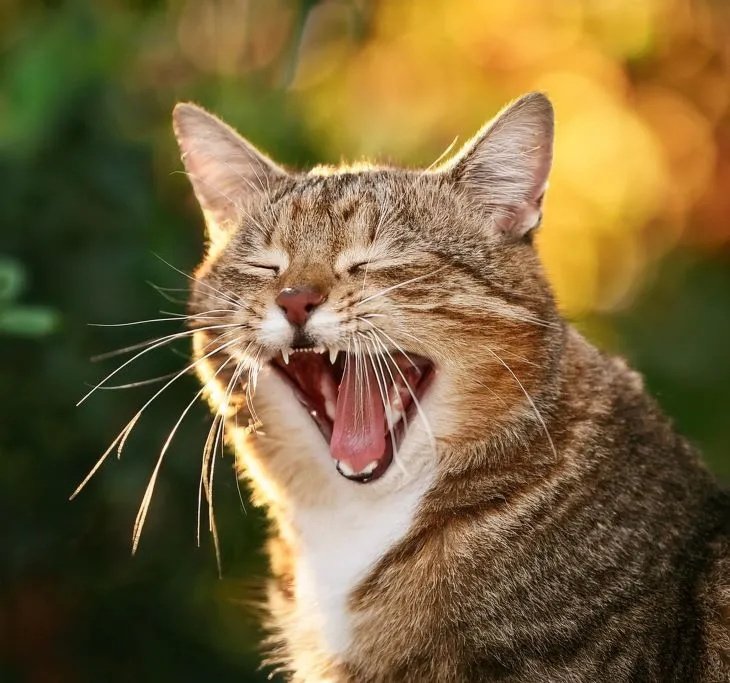How Many Teeth Do Cats Have? Interesting Facts About Cat Teeth
By: Elizabeth Rikas

The information in this article is intended to educate cat parents and is not a substitute for veterinary guidance. In case of any concerns about your cat’s health, please talk with your veterinarian.
Ever watched your cat effortlessly grab, tear, and chew their food and wondered: Actually how many teeth do cats have? The answer is 30 adult teeth, comprising 12 incisors, 4 canines, 10 premolars, and 4 molars. However, this number changes as cats grow.
Kittens begin life with only 26 baby teeth, eventually replaced by their adult set, just like humans. Understanding this tooth development—from when a kitten’s teeth first appear to when they fall out—is crucial for every cat owner.
Knowing how many teeth your cat has, the types of teeth they rely on for eating, and how to properly care for them can help prevent common dental issues. From teething kittens to adult cats, dental care is essential for their overall well-being. Keep reading to discover everything you need to know about your cat’s teeth and how to maintain their dental health for a lifetime.
The Basics: How Many Teeth Do Cats Have?
When it comes to feline dental anatomy, adult cats typically have 30 teeth—slightly fewer than the 32 teeth found in most adult humans. However, every one of these teeth is perfectly designed to support a cat’s carnivorous lifestyle. Their sharp, specialized teeth are essential for tasks like grabbing, tearing, and chewing meat, as well as for daily grooming and play.
Although 30 teeth might seem like a small number, each one plays a crucial role in your cat’s survival and overall well-being.
Types Of Cat Teeth And Their Functions
Cats have four distinct types of teeth, each serving a unique purpose in their daily activities. Let’s explore these specialized teeth and how they help your cat thrive.
1. Incisors
Your cat’s 12 incisors, with six on the top and six on the bottom, are small, chisel-shaped teeth. Despite their size, they play an important role in grooming and picking up small objects, helping cats with delicate tasks like cleaning their fur.
2. Canines (Fangs)
Cats have four prominent canines, two on the top and two on the bottom. These long, sharp teeth are essential for grabbing and tearing food, giving them the nickname “fangs.” They’re also vital for defense and hunting.
3. Premolars
Adult cats have 10 sharp-edged premolars, four on top and six on the bottom. These teeth help slice through food, allowing cats to break down meat into smaller pieces for easier chewing and digestion.
4. Molars
With just four molars—two on top and two on the bottom—cats use these flatter teeth to grind and crush food, especially when finishing off tougher pieces.
How Many Teeth Do Kittens Have?
Kittens are born without teeth, but their first set, known as deciduous or baby teeth, begins to appear between 3 and 4 weeks of age. By the time they finish teething, kittens will have a total of 26 baby teeth, consisting of 12 incisors, 4 canines, and 10 premolars. Unlike adult cats, kittens don’t have molars at this stage; these come in later with their permanent teeth.
When Do Kittens Start To Lose Their Teeth?
Kittens begin losing their baby teeth around 3 to 4 months of age, following a specific order:
- First, they shed their incisors (the small front teeth).
- Next, their canines (the sharp, pointy fangs) fall out.
- Lastly, the premolars (the teeth just behind the canines) are lost.
As these baby teeth fall out, an exciting process takes place beneath the surface. Adult teeth begin developing from tooth buds, ready to replace the baby teeth. This transition is crucial for a kitten’s growth.
When Do Kittens Get Their Adult Teeth?
Around the time kittens start losing their baby teeth, their adult teeth begin to emerge. By the age of 6 months, most kittens will have their full set of 30 adult teeth.
This tooth transition mirrors what happens in humans, where baby teeth give way to permanent ones. It’s an essential part of a kitten’s development as they grow into adulthood.
What If Kittens Retain Their Baby Teeth?
Occasionally, a kitten may retain one or more of their deciduous (baby) teeth, a condition called retained deciduous teeth. This can lead to crowding in their mouth, causing issues like:
- Food trapping and decay: When teeth are overcrowded, food particles can become trapped, leading to tartar buildup, gingivitis, and even periodontal disease.
- Bite problems: Retained baby teeth can create an abnormal bite, causing discomfort and making it difficult for your kitten to chew or eat properly.
If you notice your kitten hasn’t lost all their baby teeth by the time their adult teeth start coming in, it’s important to consult your vet. In most cases, these teeth will need to be removed to prevent future dental problems.
Related read: Kitten not drinking water
The Importance Of Feline Dental Health
Now that we’ve explored how many teeth cats have and their functions, it’s essential to understand the potential dental issues that can affect their well-being. Maintaining your cat’s dental health is crucial for preventing pain, discomfort, and more serious health complications.
Common Dental Problems In Cats
- Periodontal Disease: One of the most widespread dental issues, affecting up to 85% of cats over 3 years old. This condition begins with plaque buildup, which hardens into tartar and leads to gum inflammation, tooth loss, and even infections. Regular dental care is key to preventing this painful disease.
- Tooth Resorption (Breakdown): This condition occurs when the structure of the tooth begins to erode, causing significant pain. Affected teeth often need to be extracted as they cannot be repaired, making early detection critical.
- Fractured Teeth: Cats can suffer from broken teeth due to trauma or chewing on hard objects, like bones or toys. Fractures expose the tooth’s sensitive inner layers, which can lead to pain and infection if not treated promptly.
- Stomatitis: A severe and painful inflammation of the mouth lining, stomatitis makes it difficult for cats to eat or groom themselves. Treatment typically involves addressing the underlying cause and may include tooth extractions or medications to manage pain and inflammation.
Signs Of Dental Problems In Cats
As a responsible cat owner, it’s essential to watch for any signs of dental issues in your feline friend. Here are some common indicators that your cat may be experiencing tooth or gum problems:
- Bad breath: While mild bad breath is normal, a sudden or severe odor can signal an underlying dental issue.
- Drooling: Excessive drooling is often a sign of oral discomfort or pain.
- Difficulty eating or loss of appetite: Cats with dental problems may struggle to chew or avoid certain foods, leading to reduced appetite or weight loss.
- Pawing at the mouth: Cats in dental pain may paw at their mouth or face frequently.
- Bleeding or swollen gums: Red, swollen, or bleeding gums can be a sign of gingivitis or more advanced periodontal disease.
- Visible tartar buildup: Yellow or brown tartar buildup along the gumline can lead to infection and tooth decay.
- Changes in behavior or irritability: Dental pain may cause your cat to become more irritable or withdrawn.
If you notice any of these symptoms, it’s crucial to take your cat to the vet as soon as possible. Early intervention can prevent more serious health problems.
Tips On Maintaining Your Cat’s Dental Health
Taking care of your cat’s teeth is vital for their overall health. Here are some simple yet effective ways to keep your cat’s teeth in top shape:
- Regular Brushing: Daily brushing with a cat-specific toothbrush and toothpaste is the best way to prevent dental issues. With patience and positive reinforcement, it can become routine.
- Dental Treats And Toys: These help reduce plaque and tartar buildup but are not a replacement for regular brushing.
- Professional Cleanings: Routine vet check-ups ensure thorough cleanings and prevent periodontal disease. Cats may need their first cleaning between 1 to 3 years, with older cats needing evaluation for safe anesthesia.
Interesting Read: Can Cats Eat Raw Meat?
Conclusion
In summary, adult cats have 30 teeth, each serving a unique purpose—from sharp canines for catching prey to incisors for grooming. As cat owners, maintaining their dental health is essential. Remember to:
- Schedule regular vet check-ups.
- Brush their teeth at home.
- Monitor for signs of oral discomfort.
By following these simple steps, you can keep your cat’s teeth healthy, ensuring they stay happy and comfortable for years to come.
FAQ’s About Cat Teeths

About the Author
Elizabeth Rikas
Elizabeth is a passionate advocate for feline health and well-being, drawing from her years as a dedicated pet parent to three cats—Gypsy, Swan, and Alfred—and her invaluable experience volunteering at animal shelters. A seasoned writer with a lifelong love for cats, Elizabeth began sharing her insights in her teens and has since contributed extensively to platforms focused on feline care. Through her expertise and heartfelt dedication, she empowers pet owners with practical advice and research-backed knowledge to nurture their furry companions.
